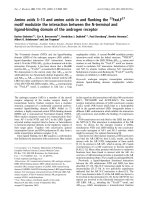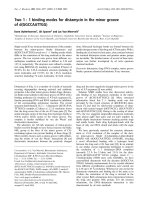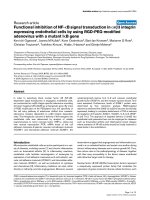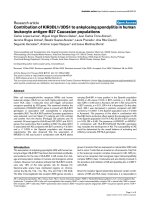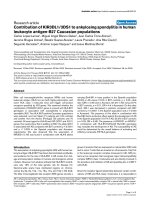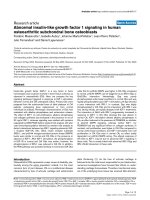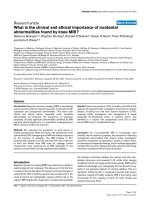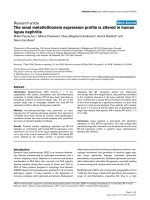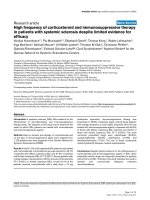Báo cáo y học: " Phosphodiesterase type 4 expression and anti-proliferative effects in human pulmonary artery smooth muscle cells" docx
Bạn đang xem bản rút gọn của tài liệu. Xem và tải ngay bản đầy đủ của tài liệu tại đây (448.7 KB, 12 trang )
BioMed Central
Page 1 of 12
(page number not for citation purposes)
Respiratory Research
Open Access
Research
Phosphodiesterase type 4 expression and anti-proliferative effects
in human pulmonary artery smooth muscle cells
Ellena J Growcott
1
, KarenGSpink
2
, Xiaohui Ren
1
, Saliha Afzal
1,3
,
Kathy H Banner
2,4
and John Wharton*
1
Address:
1
Section on Experimental Medicine and Toxicology, Imperial College London, Hammersmith Campus, Du Cane Road, London W12
0NN, UK,
2
Pfizer Global Research and Development, Discovery Biology, Ramsgate Road, Sandwich, Kent CT13 9NJ, UK,
3
MRC London
Neurodegenerative Diseases Brain Bank, Institute of Psychiatry, Windsor Walk, London SE5 8AF UK and
4
Novartis Institute for BioMedical
Research, Wimblehurst Road, Horsham, West Sussex RH12 5AB, UK
Email: Ellena J Growcott - ; Karen G Spink - ; Xiaohui Ren - ;
Saliha Afzal - ; Kathy H Banner - ; John Wharton* -
* Corresponding author
Abstract
Background: Pulmonary arterial hypertension is a proliferative vascular disease, characterized by aberrant
regulation of smooth muscle cell proliferation and apoptosis in distal pulmonary arteries. Prostacyclin (PGI
2
)
analogues have anti-proliferative effects on distal human pulmonary artery smooth muscle cells (PASMCs), which
are dependent on intracellular cAMP stimulation. We therefore sought to investigate the involvement of the main
cAMP-specific enzymes, phosphodiesterase type 4 (PDE4), responsible for cAMP hydrolysis.
Methods: Distal human PASMCs were derived from pulmonary arteries by explant culture (n = 14, passage 3–
12). Responses to platelet-derived growth factor-BB (5–10 ng/ml), serum, PGI
2
analogues (cicaprost, iloprost) and
PDE4 inhibitors (roflumilast, rolipram, cilomilast) were determined by measuring cAMP phosphodiesterase
activity, intracellular cAMP levels, DNA synthesis, apoptosis (as measured by DNA fragmentation and nuclear
condensation) and matrix metalloproteinase-2 and -9 (MMP-2, MMP-9) production.
Results: Expression of all four PDE4A-D genes was detected in PASMC isolates. PDE4 contributed to the main
proportion (35.9 ± 2.3%, n = 5) of cAMP-specific hydrolytic activity demonstrated in PASMCs, compared to PDE3
(21.5 ± 2.5%), PDE2 (15.8 ± 3.4%) or PDE1 activity (14.5 ± 4.2%). Intracellular cAMP levels were increased by
PGI
2
analogues and further elevated in cells co-treated with roflumilast, rolipram and cilomilast. DNA synthesis
was attenuated by 1 µM roflumilast (49 ± 6% inhibition), rolipram (37 ± 6%) and cilomilast (30 ± 4%) and, in the
presence of 5 nM cicaprost, these compounds exhibited EC
50
values of 4.4 (2.6–6.1) nM (Mean and 95%
confidence interval), 59 (36–83) nM and 97 (66–130) nM respectively. Roflumilast attenuated cell proliferation and
gelatinase (MMP-2 and MMP-9) production and promoted the anti-proliferative effects of PGI
2
analogues. The
cAMP activators iloprost and forskolin also induced apoptosis, whereas roflumilast had no significant effect.
Conclusion: PDE4 enzymes are expressed in distal human PASMCs and the effects of cAMP-stimulating agents
on DNA synthesis, proliferation and MMP production is dependent, at least in part, on PDE4 activity. PDE4
inhibition may provide greater control of cAMP-mediated anti-proliferative effects in human PASMCs and
therefore could prove useful as an additional therapy for pulmonary arterial hypertension.
Published: 19 January 2006
Respiratory Research 2006, 7:9 doi:10.1186/1465-9921-7-9
Received: 01 November 2005
Accepted: 19 January 2006
This article is available from: />© 2006 Growcott et al; licensee BioMed Central Ltd.
This is an Open Access article distributed under the terms of the Creative Commons Attribution License ( />),
which permits unrestricted use, distribution, and reproduction in any medium, provided the original work is properly cited.
Respiratory Research 2006, 7:9 />Page 2 of 12
(page number not for citation purposes)
Background
The survival of vascular smooth muscle cells is dependent
on the balance between proliferation and apoptosis and
the aberrant regulation of these pathways is implicated in
proliferative vascular diseases such as pulmonary arterial
hypertension (PAH); a progressive disease characterized
by remodelling of distal pulmonary arteries [1]. Attention
has therefore focused on therapies directed at suppressing
proliferation and resistance to apoptosis in pulmonary
artery smooth muscle cells (PASMCs) [2-4]. The ubiqui-
tous second messenger cyclic adenosine monophosphate
(cAMP) represents a potential target as it is one of the
main intracellular factors regulating cell proliferation and
apoptosis [5]. Prostacyclin analogues are an established
vasodilator therapy for PAH that act mainly via IP recep-
tors to stimulate adenylyl cyclase and intracellular cAMP
levels [6], but also have anti-proliferative actions on
human PASMCs, which may be important for their long-
term effects in vivo [7,8]. The relationship between cAMP
elevation and anti-proliferative potency of prostacyclin
analogues is not necessarily clear [8], but additional strat-
egies directed at elevating cAMP and amplifying the effects
of prostacyclin signalling may be useful, particularly when
the prostanoid is administered by repeated inhalation [9].
Phosphodiesterase (PDE) enzymes are responsible for the
hydrolysis of the cyclic nucleotides and therefore have a
critical role in regulating cAMP levels and downstream
signalling in the cardiovascular system [10]. Eleven fami-
lies of PDEs have been identified and of these PDE4 is the
main cAMP specific PDE identified in the lung and vascu-
lature [11,12]. PDE4 proteins are encoded by four genes
(PDE4A, PDE4B, PDE4C and PDE4D), which produce
numerous PDE4 variants [10,13] and studies on rat pul-
monary arteries [14] and isolated PASMCs [15] suggest
that these genes may be differentially expressed in the pul-
monary vasculature. The presence of PDE4 has been
investigated in homogenates of large human pulmonary
arteries [16], but not in distal regions of the human pul-
monary vasculature. Together with PDE3 enzymes the
PDE4 family contributes to the regulation of pulmonary
vascular tone, PDE4 inhibitors inducing relaxation of pul-
monary artery preparations [14,16,17] and amplifying
agonist-induced vasodilator responses [18,19]. On the
other hand, the role of PDE4 in modulating vascular
structure is unclear, studies to date indicating that when
used alone PDE4 inhibitors are capable of suppressing the
migration of isolated smooth muscle cells [20,21], but
appear to be less effective at inhibiting vascular smooth
muscle cell proliferation [15,22].
The mechanisms underlying remodelling of pulmonary
arteries in PAH are multifactorial and include abnormali-
ties in signalling by the TGF-beta superfamily, serotonin
receptors and transporter, potassium channels, endothe-
lial-derived factors and growth factors [23,24]. Proteolytic
enzymes are also thought to be involved, including
elastase and matrix metalloproteinases (MMP) such as the
gelatinases MMP-2 and MMP-9, which degrade collagen
and elastin, regulate extracellular matrix (ECM) deposi-
tion, and contribute to smooth muscle cell migration and
proliferation [25,26]. Activation of these enzymes also
leads to the production of the ECM protein tenascin-C,
which acts as a survival factor, promoting proliferation
and suppressing apoptosis in PASMCs [2]. An additional
and potentially important role of MMP-2 is the regulation
of vascular tone and structure, via the cleavage of vasoac-
tive peptides [27]. In patients with PAH, MMP-2 and
membrane type 1-MMP (MT1-MMP), a cell-surface activa-
tor of MMP-2, are co-localized in pulmonary vascular
lesions [28] and isolated PASMCs exhibit increased gelati-
nase activity compared with controls [29]. Previous stud-
ies have suggested the involvement of the cAMP signalling
pathway in regulating MMP-2 and MMP-9 production in
a variety of human cell types [30,31]. cAMP-elevating
agents have also been found to suppress MT1-MMP activ-
ity [32] and upregulate tissue inhibitors of MMPs [33],
however, it is uncertain whether agents such as prostacyc-
lin analogues and PDE inhibitors modulate gelatinase
activity in human PASMCs.
We therefore sought to establish (1) the expression of
PDE4A-D genes in human distal PASMCs; (2) the contri-
bution of PDE4 to cAMP hydrolytic activity in these cells;
and (3) the role of PDE4 in regulating cAMP levels, DNA
synthesis, proliferation, apoptosis and gelatinase activity,
using selective PDE4 inhibitors alone and in combination
with prostacyclin analogues.
Methods
Isolation of PASMCs and culture
Lung tissues were obtained at lung transplantation
(emphysema n = 8; pulmonary fibrosis n = 2; unused
donor n = 1) and at lobectomy or pneumonectomy for
bronchial carcinoma (n = 3), with informed consent and
local approval from Hammersmith and Brompton-Hare-
field Hospitals ethics committees. Distal pulmonary
artery smooth muscle cells (PASMCs) were isolated from
micro-dissected segments of artery (<1 mm external diam-
eter), as previously described [7]. Explants were placed in
Dulbecco's modified Eagle medium (DMEM) containing
20% (v/v) foetal bovine serum (FBS) and 1% (v/v) antibi-
otic/antimycotic at 37°C, 5% CO
2
. Cells were maintained
in DMEM containing 5–10% FBS and used at passages 3–
12. For experiments confluent cells were made quiescent
by incubation with serum-free media for 48 h and
responses to platelet-derived growth factor (PDGF)-BB
(5–10 ng/ml), prostacyclin analogues (cicaprost, iloprost)
and PDE inhibitors were determined, as described below.
When confluent, these cell isolates formed sheets of spin-
Respiratory Research 2006, 7:9 />Page 3 of 12
(page number not for citation purposes)
dle-shaped cells and, like smooth muscle cells in the
medial layer of intact distal human pulmonary arteries,
expressed α-smooth muscle actin, calponin, endothelin
ET
A
and ET
B
receptors and phosphodiesterase type 5
[7,34].
PDE4 gene expression
Total cellular RNA was prepared using RNeasy Mini Kits
and 0.2 µg of RNA was reverse transcribed into cDNA
using a Superscript™ first strand synthesis kit (Invitrogen
Ltd., Paisley, Scotland, UK). PCR was performed using
proof start DNA polymerase (Qiagen Ltd., Crawley, West
Sussex, UK), using 2 µl of reverse-transcribed cDNA solu-
tion (25 µl total volume), for 25–33 cycles with denatur-
ation at 94°C for 30 sec, annealing at 55°C (β-actin) or
57°C (PDE4) for 30 sec and extension at 72°C for 1 min.
This was followed by a final extension for 7 min at 72°C.
After amplification, 10 µl of PCR product was separated
using electrophoresis on a 1% (w/v) agarose gel and
bands were identified using a ChemiGenius BioImaging
system (Syngene, Cambridge, UK). The PDE4 primer
sequences have been previously published [35] and PCR
product identity was confirmed by cloning into E.coli
using Zero Blunt Topo PCR cloning kit (Invitrogen) and
sequencing (Lark Technologies Inc., Takeley, Essex, UK).
Phosphodiesterase activity assay
cAMP-PDE activity was determined using a procedure
modified from the Thompson and Appleman two-step
conversion method, as previously described [34]. Briefly,
cAMP-PDE activity was measured in both cytosolic and
membrane fractions of PASMCs with 0.5 µM substrate
(0.1 µM
3
H-labelled cAMP, 0.4 µM unlabelled cAMP),
and characterised using selective PDE inhibitors.
Intracellular cAMP levels
cAMP levels were determined using an Adenylyl Cyclase
Activation Flashplate
®
assay (PerkinElmer Life and Analyt-
ical Sciences, Boston, MA), according to the manufactur-
ers instructions. Briefly, cells from a T175 cm
2
cell culture
flask were trypsinised, washed once in phosphate buffered
saline (PBS) without calcium or magnesium and re-sus-
pended in stimulation buffer without IBMX. Re-sus-
pended cells (50 µl/well) were treated with PDE inhibitors
for 10–20 min before the addition of prostacyclin ana-
logues or forskolin for 60 min at 37°C. This time point
was selected on the basis of our earlier observations,
showing a maximal response to cicaprost in human PAS-
MCs [7]. Detection buffer (100 µl), containing [
125
I]-
cAMP, permeabilizer and 0.09% sodium azide, was
added, incubated for 3 h at room temperature, and radio-
activity counted using a TopCount NXT microplate coun-
ter (Packard, Pangbourne UK). Unlabelled cAMP
standards (10–1000 pmol/well) were included in the
same plate and results expressed as pmol cAMP produced
per 10
5
cells, with at least 4 replicates per treatment.
DNA synthesis, cell proliferation and apoptosis
DNA synthesis was measured by [
3
H-methyl]-thymidine
incorporation over 24 h. Cells were seeded in 48-well
plates (5 × 10
4
cells/well) in DMEM containing 5% FBS,
allowed to adhere overnight, and then quiesced for 48 h
in serum-free DMEM. Cells were subsequently incubated
in fresh medium containing 0.25 µCi/well [
3
H-methyl]-
thymidine, in the presence of PDGF-BB (5–10 ng/ml).
PDE inhibitors and/or prostacyclin analogues were added
30–45 min before the addition of mitogen and [
3
H-
methyl]-thymidine and the incorporation of thymidine
was determined by liquid scintillation analysis, as previ-
ously described [7].
To determine cell proliferation, cells were seeded in 24-
well plates (2 × 10
4
cells/ well) in DMEM containing 5%
FBS and allowed to adhere overnight. The media was then
replaced with fresh media containing drugs (4 replicate
wells each) and changed every 2–3 days for up to 13 days.
Adherent cells were trypsinised, counted and viability
assessed by trypan blue exclusion.
The effects of PDE4 inhibition and cAMP signaling on
apoptosis were assessed using Hoechst 33342 staining to
define nuclear chromatin morphology and a cell death
detection ELISA kit (Roche Diagnostics Ltd. (Lewes, Sus-
sex, UK) to determine cytoplasmic histone-associated-
DNA fragments. Cells were either maintained in media
containing 5% FBS or serum-deprived for 48 h and treated
with either iloprost (10
-10
to 10
-7
M) or roflumilast (10
-9
to 10
-6
M) for 48 h. PASMCs were cultured in 8-well per-
manox chamber slides (Lab-Tek™; Nalge Nunc Interna-
tional, Naperville, IL) for Hoechst 33342 staining (5 µg/
Phosphodiesterase type 4 (PDE4) expression in human pul-monary artery smooth muscle cellsFigure 1
Phosphodiesterase type 4 (PDE4) expression in
human pulmonary artery smooth muscle cells. RT-
PCR demonstration of PDE4A (546 bp), PDE4B (506 bp),
PDE4C (410 bp), PDE4D (479 bp) expression in a PASMC
isolate, which is representative of 4 separate cell lines. Con-
trols included expression of β-actin and absence of reverse
transcriptase (- RT) or RNA (- RNA).
300 bp
P
D
E
4
A
P
D
E
4
B
P
D
E
4
C
P
D
E
4
D
E
-
A
c
t
i
n
-
R
T
-
R
N
A
123 456 78
500 bp
100 bp
Respiratory Research 2006, 7:9 />Page 4 of 12
(page number not for citation purposes)
ml for 20 min at 20°C) and individual nuclei were
counted in at least 5 randomly selected fields for each well
(>90 cells/field). The number of apoptotic cells exhibiting
condensed nuclear fluorescence was determined and
expressed as a proportion of the total cells. DNA fragmen-
tation was determined using cells grown in 24-well plates,
according to the manufacturers instructions.
Gelatin zymography and matrix metalloproteinase
production
Cells, seeded in 24-well plates (2 × 10
4
cells/well), were
cultured in medium containing 10% FBS for at least 2
days before being serum-deprived for 24 h. Cells were
incubated in fresh serum-free medium and stimulated
with 10 ng/ml recombinant human tumour necrosis fac-
tor-α (TNF-α), interleukin-1β (IL-1β) or transforming
growth factor-β1 (TGF-β1), phorbol 12-myristate 13-ace-
tate (PMA, 10
-7
M) or the inactive phorbol ester 4α-PMA
(10
-7
M), in the absence and presence of drugs at specified
concentrations. The medium was collected after 48 h and
gelatinase (MMP-2 and MMP-9) activity visualized by
zymography and measured using MMP-2 and MMP-9
human Biotrack™ ELISA systems (Amersham Biosciences
UK Ltd., Little Chalfont, Bucks, UK), according to the
manufacturer's instructions. Conditioned medium was
separated, under non-reducing conditions, in an 8% SDS-
polyacrylamide gel, containing 1 mg/ml gelatin, at 4°C.
After electrophoresis, gels were incubated in 2.5% Triton
X-100 (twice for 15 min) to remove SDS, washed in water
and incubated overnight at 37°C in buffer containing 50
mM Tris-HCl (pH 8.0), 5 mM CaCl
2
, 1 µM ZnCl
2
and
0.1% Triton X-100. After fixation in 25% isopropanol and
10% acetic acid for 10 min, gels were stained in 0.25%
Coomassie blue for 1–2 h. and destained in fixing/destain
solution until bands of activity were clearly visible. The
presence of MMP activity was confirmed by inhibition
with 10 mM EDTA and the use of purified gelatinases
(Merck Biosciences Ltd., Nottingham, UK) following acti-
vation with 1.5 mM p-aminophenyl mercuric acetate
(APMA).
Statistical analysis
Data were expressed as mean ± SEM or 95% confidence
interval (95% CI) and analysed using GraphPad Prism
version 4.0 (GraphPad software, San Diego, CA). Com-
parisons were made using one-way analysis of variance,
with a Tukey post hoc test, or student's t-test, as appropri-
ate. A value of P < 0.05 was taken to be significant.
Results
PDE4 gene expression and activity
Products of 546, 506, 410 and 479 base pairs (bp), corre-
sponding to fragments of PDE4A, PDE4B, PDE4C and
PDE4D respectively were amplified by RT-PCR from distal
human PASMCs total RNA (Figure 1). RNA amplification
was not observed when either reverse transcriptase or RNA
was omitted from the reaction, indicating that genomic
DNA contamination was not present. The alignment of
the sequenced RT-PCR products with corresponding
Characterisation of cAMP phosphodiesterase (PDE) activity in human PASMCsFigure 2
Characterisation of cAMP phosphodiesterase (PDE)
activity in human PASMCs. Total cAMP hydrolytic activ-
ity and contribution of PDE enzyme families to cAMP hydrol-
ysis in the cytosol (A) and membrane fractions (B) of human
PASMCs (n = 5 isolates). Activity inhibited by 10
-3
} M EGTA
(PDE1), 10
-5
M EHNA (PDE2), 10
-5
M cilostamide (PDE3) and
10
-6
M roflumilast (PDE4).
(A)
(B)
0
25
50
75
PDE2
Total PDE1 PDE3 PDE4 Other
cAMP-PDE activity (pmol/min/mg protein)
0
10
20
30
40
PDE2
Total PDE1 PDE3 PDE4 Other
cAMP-PDE activity (pmol/min/mg protein)
Respiratory Research 2006, 7:9 />Page 5 of 12
(page number not for citation purposes)
regions in the human PDE4 isoforms confirmed their
identity as PDE4 products (data not shown).
Both subcellular fractions displayed cAMP-PDE activity,
the cytosol containing more activity than the membrane
fraction (56.4 ± 6.4 versus 31.8 ± 3.9 pmol/min/mg pro-
tein; P < 0.001; n = 5 isolates). The hydrolytic activity was
attenuated by the non-selective PDE inhibitor IBMX (5 ×
10
-4
M), which reduced enzyme activity in both the
cytosolic (100.7 ± 4.3% inhibition) and membrane frac-
tions (78.1 ± 5.7% inhibition) respectively. PDE1 activity
was determined by inhibition with 10
-3
M EGTA and the
contribution of other enzymes using selective inhibitors
of PDE2 (10
-5
M EHNA), PDE3 (10
-5
M cilostamide) and
PDE4 activity (10
-6
M roflumilast). Each of these enzyme
families contributed to the cytosolic and membrane
cAMP-PDE activity (Figure 2A–B). PDE4 was the main
specific cAMP hydrolytic activity demonstrated and con-
tributed a greater proportion of the total activity (35.9 ±
2.3%; P < 0.01; n = 5) compared to PDE3 (21.5 ± 2.5%),
PDE2 (15.8 ± 3.4%) or PDE1 activity (14.5 ± 4.2%).
Effects of PDE inhibition on intracellular cAMP levels
Treatment with roflumilast (10
-6
M) raised intracellular
cAMP levels approximately 2-fold to 30.7 ± 7.4 pmol/10
5
cells (n = 6) (Figure 3A) and cilostamide (10
-6
M) induced
a similar increase (39.2 ± 3.0 pmol/10
5
cells, n = 3). Stim-
ulation of PASMCs with adenylyl cyclase activators, such
as the prostacyclin analogue iloprost, had a concentra-
tion-dependent effect on intracellular cAMP levels, induc-
ing a 4- (10
-8
M) to 19-fold (10
-6
M) elevation, which was
augmented a further 2 to 3-fold by co-treatment with rof-
lumilast (Figure 3B).
Effects of PDE4 inhibition on DNA synthesis, cell
proliferation and apoptosis
Stimulation of PASMCs with PDGF-BB (10 ng/ml)
increased [methyl-
3
H]-thymidine incorporation >4-fold
over 24 hours (P < 0.001, n = 5). DNA synthesis was atten-
uated by both PDE4 (roflumilast, rolipram and cilomi-
last) and PDE3 (cilostamide) selective inhibitors,
although the inhibitory effect of cilostamide was less than
that observed following treatment with PDE4 inhibitors
(Figure 4A). Co-treatment with cicaprost and PDE4 inhib-
itors also amplified the agonist-induced inhibition of
DNA synthesis in a concentration-dependent manner
(Figure 4B), with a rank order of roflumilast (EC
50
value
4.4 nM; 95% CI [2.6 to 6.1 nM]; P < 0.001; n = 6), rol-
ipram (EC
50
value 59 nM; 95% CI [36 to 83 nM]; P < 0.01;
n = 4) and cilomilast (EC
50
value 97 nM; 95% CI [66 to
130 nM]; n = 4).
Roflumilast (10
-6
M) attenuated serum-stimulated
PASMC proliferation (Figure 4C) as well as DNA synthesis
and dual treatment with iloprost (10
-7
M) and roflumilast
had a significantly greater anti-mitogenic effect (45.9 ± 2.7
% inhibition), compared to iloprost alone (29.8 ± 4.0 %
inhibition; P < 0.05, n = 4 isolates) (Figure 4D). In addi-
tion to suppressing cell proliferation iloprost activated
apoptosis, as demonstrated by a concentration-dependent
increase in nuclear chromatin condensation and DNA
fragmentation (Figure 5A–B). The adenylyl cyclase activa-
tor forskolin also induced an apoptotic response whereas
treatment with PDE4 (roflumilast) and PDE3 inhibitors
(cilostamide) alone had no significant effect on DNA frag-
mentation (Figure 5C). The combined effect of roflumi-
last and iloprost tended to be greater than iloprost alone,
but overall the additional effect was not significant. The
Effect of roflumilast on intracellular cAMP levelsFigure 3
Effect of roflumilast on intracellular cAMP levels.
Increase in cAMP levels following PDE4 inhibition with 10
-6
M
roflumilast (A) and dual treatment with iloprost (B). Data
(mean ± SEM) from 6 PASMC isolates (A) and four repli-
cates, which is representative of three experiments with dis-
tinct isolates (B).
0
200
400
600
0
-8 -7 -6
Roflumilast (-6 M)
P<0.001
Iloprost (log M)
cAMP (pmol/10
5
cells)
0
10
20
30
40
P<0.01
SF
Roflumilast (-6 M)
cAMP (pmol/10
5
cells)
(A)
(B)
Respiratory Research 2006, 7:9 />Page 6 of 12
(page number not for citation purposes)
effects of PDE4 inhibition on DNA synthesis, cell prolifer-
ation and apoptosis were reproducible between different
cell isolates, irrespective of whether they were derived
from normal or diseased lung tissues.
Effects of iloprost and roflumilast on MMP production
Untreated, quiescent PASMCs displayed mainly pro-
MMP-2 (72 kDa), rather than activated MMP-2 isoforms
(66 kDa and 62 kDa), and did not display MMP-9 activity
(Figure 6). Treatment of cells with PMA (10
-7
M) for 48
hours induced proMMP-9 (92 kDa), which was attenu-
ated by dexamethasone and in turn blocked by co-treat-
ment with the progesterone receptor antagonist
mifepristone (Figure 6A). Stimulation with cytokines
alone had relatively little effect on gelatinase activity,
whereas dual treatment with PMA had a synergistic effect
on MMP-9 induction (Figure 6A). The response was
greater for TNF-α and IL1-β, compared to TGF- β1, and
was not observed when the inactive phorbol ester 4α-PMA
was used. MMP-9 activity was attenuated following stim-
ulation with the adenylyl cyclase activator forskolin and,
in a concentration dependent-manner, by the prostacyclin
analogue cicaprost (Figures 6B &7A–B), suggesting regula-
tion via the cAMP signalling pathway. Indeed, roflumilast
Anti-mitogenic effects of PDE4 inhibition in PASMCsFigure 4
Anti-mitogenic effects of PDE4 inhibition in PASMCs. Effects of PDE4 (cilomilast, rolipram, roflumilast) and PDE3
(cilostamide) inhibitors on PDGF-BB (5 ng/ml) stimulated DNA synthesis (A). Concentration-dependent effect of roflumilast,
combined with a sub-maximal concentration of cicaprost, on [methyl-
3
H]-thymidine incorporation (B). Effect of roflumilast (10
-
6
M, open squares) on serum-stimulated (5% FBS) cell growth (closed squares) (C) and combined inhibitory effect of iloprost
(10
-7
M) after 10 days serum-stimulated growth (D). *, P < 0.05; **, P < 0.01; ***, P < 0.001 versus control cells stimulated with
either PDGF-BB (A), cicaprost (B) or serum (C-D). Data represent mean ± SEM from four-six distinct isolates (A-B, D) and
four replicates (C).
-60
-40
-20
0
Cilomilast Roflumilast
*
***
**
Rolipram Cilostamide
P<0.05
P<0.001
*
(-6 M) (-6 M) (-6 M) (-6 M)
[Methyl-
3
H]-thymidine
incorporation (% inhibition)
-90
-80
-70
-60
-50
0 -10 -9 -8 -7 -6
Cicaprost
(-8.3 M)
***
***
***
Roflumilast (log M)
[Methyl-
3
H]-thymidine
incorporation (% inhibition)
0 2 4 6 8 10 12 14
0
10
20
30
40
P<0.05
Serum
Roflumilast (-6 M)
Day
Cell number well
-1
(x10
4
)
-50
-40
-30
-20
-10
0
5% FBS
Iloprost (-7 M)
Roflumilast (-6 M)
***
***
P<0.05
Proliferation (% inhibition)
(A) (B)
(C) (D)
Respiratory Research 2006, 7:9 />Page 7 of 12
(page number not for citation purposes)
attenuated MMP-9 activity and enhanced the inhibitory
response to prostanoid stimulation in cells co-treated
with a sub-maximal concentration of iloprost (Figure
7D). The treatment of cells with cytokines and PMA stim-
ulated constitutive pro-MMP-2 (72 kDa) expression and
activation of MMP-2 (66 kDa and 62 kDa) (Figures 6A–
B), which was attenuated by roflumilast and iloprost (Fig-
ures 6 &8).
Discussion
This study provides evidence indicating that the elevation
of intracellular cAMP by prostacyclin analogues and PDE4
inhibitors suppresses proliferation and MMP activity and
promotes apoptosis in distal human PASMCs.
The expression of PDE4A, PDE4B, PDE4C and PDE4D
genes was detected in isolated human PASMCs. This is
consistent with investigations demonstrating the expres-
sion of all four genes in systemic human arteries as well as
other tissues [36] and contrasts with studies on rat pulmo-
nary arteries [14] and isolated PASMCs [15] where PDE4
genes were found to be differentially expressed. In cul-
tured human PASMCs, PDE3 and PDE4 represented the
major cAMP hydrolyzing enzymes, the contribution of
PDE4 being greater than that of PDE3. Studies examining
PDE activity in extracts of human [16], bovine [17] and rat
pulmonary arteries [37] have also demonstrated that
PDE3 and PDE4 predominate, but with more PDE3 than
PDE4 activity occurring in proximal regions of the pulmo-
nary vascular bed, suggesting that there may be regional
differences in the distribution of PDE4 activity. However,
it should be borne in mind that the contribution of differ-
ent PDEs to cAMP hydrolysis is a dynamic process, regu-
lated by factors such as intracellular calcium levels and
signalling activity. For example, we have shown that PDE1
activity is markedly induced in human PASMCs following
stimulation with calcium and calmodulin [34] and it is
now recognized that the cAMP-protein kinase A pathway
regulates the expression [38] and catalytic activity of PDE4
variants [10,13] as well as the association of PDE4
enzymes with intracellular anchoring proteins [39].
Selective PDE4 inhibitors were found to attenuate DNA
synthesis in human PASMCs. Of the inhibitors examined,
roflumilast appeared most potent, the rank order of
potency for the inhibition of DNA synthesis (roflumilast
> rolipram > cilomilast) corresponding to that reported
for the inhibition of human leukocyte cell functions [40]
and inflammatory responses in experimental models of
airway disease [41]. Roflumilast has also been identified
as an oral anti-inflammatory treatment for chronic
obstructive airway disease [42].
Cells treated with either a PDE4 or PDE3 inhibitor exhib-
ited a comparable (~2-fold) increase in intracellular
Pro-apoptotic effects of cAMP elevating agentsFigure 5
Pro-apoptotic effects of cAMP elevating agents. Con-
centration-dependent effect of iloprost on apoptosis, as dem-
onstrated by the proportion of Hoechst-stained cells
showing characteristic condensed nuclear fluorescence (A)
and measurement of DNA fragmentation in human PASMCs
(B). Effects of PDE4 inhibition (10
-6
M roflumilast) and adeny-
lyl cyclase activation (10
-5
M forskolin) on DNA fragmenta-
tion (C). Data represent mean ± SEM of four replicates in
three distinct isolates. * P < 0.05, ** P < 0.01 and *** P <
0.001 versus untreated control cells in serum free (SF)
medium.
0
4
8
12
SF -10 -9 -8
Iloprost (log M)
*
***
FBS
Apoptotic cells (% of total)
0.00
0.25
0.50
0.75
1.00
0-9
-10 -8 -7
**
***
Iloprost (log M)
Absorbance at 405 nm
0.0
0.1
0.2
0.3
0.4
0.5
***
***
***
Iloprost (-7)
Roflumilast (-6)
Forskolin (-5)
-
-
-
-
-
-
-
-
+
+
+
+
+
Absorbance at 405 nm
(A)
(B)
(C)
Respiratory Research 2006, 7:9 />Page 8 of 12
(page number not for citation purposes)
cAMP, whereas PDE4 inhibitors such as roflumilast were
generally found to be more potent than cilostamide in
suppressing PDGF-stimulated DNA synthesis. In previous
studies on human airway smooth muscle cells and rat
PASMCs, a similar disparity in the capacity of PDE inhib-
itors to elevate cAMP and modulate functions such as cell
migration and proliferation was attributed to the intracel-
lular compartmentalization of cAMP signalling [15,21].
Indeed, PDE4 isoforms are known to target particular
intracellular sites and processes, resulting in the local reg-
ulation of cAMP generation and signalling, so that cAMP
gradients within cells are likely to be more functionally
relevant than cAMP levels in cells as a whole [13,39].
Nonetheless, prostacyclin analogues exhibited a greater
capacity to elevate cAMP and inhibit DNA synthesis, pro-
liferation and MMP production in PASMCs, compared to
PDE4 inhibitors. Furthermore, in cells treated with sub-
maximal concentrations of prostacyclin analogues, the
combination of roflumilast and iloprost or cicaprost had
a synergistic effect on cell function as well as cAMP levels.
Thus, selective PDE4 inhibition may provide greater con-
trol of cAMP-mediated anti-proliferative effects in distal
Gelatin zymography of matrix-metalloproteinase (MMP) in conditioned medium from human PASMCsFigure 6
Gelatin zymography of matrix-metalloproteinase (MMP) in conditioned medium from human PASMCs. Repre-
sentative zymograms showing the effects of phorbol 12-myristate 13-acetate (PMA, 10
-7
M) and 10 ng/ml TNF-α, IL-1β or TGF-
β1 on inducible MMP-9 activity after 48 h (A) and the concentration-dependent inhibitory effect of cicaprost (B). MMP-9
(proMMP-9, 92 kDa); MMP-2 (proMMP-2, 72 kDa; active isoforms, 66 kDa and 62 kDa); MMP-2+, APMA-activated MMP-2;
Dex, dexamethasone; Mif, mifepristone; 4α-PMA, inactive phorbol ester.
PMA + 4Į-PMA +PMA +
MMP-9
92 kDa
MMP-2
72 kDa
T
N
F
-
Į
I
L
1
-
ȕ
T
G
F
-
ȕ
1
T
N
F
-
Į
I
L
1
-
ȕ
T
G
F
-
ȕ
1
T
N
F
-
Į
I
L
1
-
ȕ
T
G
F
-
ȕ
1
D
e
x
D
e
x
+
M
i
f
00
(A)
(B)
0 PMA + TNF-Į 0 PMA + IL-1ȕ
-7 -8 -9 -10
Cicaprost (log M)
0
-7 -8 -9 -10
Cicaprost (log M)
0
92 kDa
72 kDa
66 kDa
62 kDa
MMP-2+
Respiratory Research 2006, 7:9 />Page 9 of 12
(page number not for citation purposes)
human PASMCs. Support for the therapeutic potential of
combined treatment with a prostacyclin analogue and
cAMP-PDE inhibitor comes from studies on monocrota-
line- [43] and hypoxia-induced rat models of pulmonary
hypertension [15], the anti-proliferative effects of iloprost
in vivo being potentiated by the inhibition of PDE4 and/
or PDE3 hydrolytic activity.
Such interaction is perhaps not surprising given the criti-
cal role of the cAMP-protein kinase A signalling pathway
in regulating the expression, activity and intracellular
localization of PDE4 isoforms in vascular smooth muscle
cells [10,13,38,39]. However, PDE4 isoforms are widely
expressed in mammalian tissues and PDE4 inhibitors,
including cilomilast and roflumilast, have a low therapeu-
tic ratio due to unwanted effects such as nausea and eme-
sis [44]. Administering the PDE4 inhibitor by inhalation
could overcome this limitation and because of the syner-
gistic interaction between PDE4 inhibitors and prostacyc-
lin analogues, it may be possible to achieve a greater
therapeutic ratio by using a combination of these drugs.
Indeed, selective PDE4 inhbitors for inhalation are in
Inhibitory effect of cAMP elevating agents on MMP-9 activityFigure 7
Inhibitory effect of cAMP elevating agents on MMP-9 activity. ELISA data of total MMP-9 activity in conditioned
medium after 48 h, showing stimulation following treatment of PASMCs with PMA (10
-7
M) and TNF-α (10 ng/ml) and its inhi-
bition by cicaprost and forskolin (A-B). Inhibitory effect of roflumilast, both alone (C) and in combination with a sub-maximal
concentration of cicaprost (D). Data represent mean ± SEM of four replicates (A-B) and three-four distinct PASMC isolates
(C-D). * P < 0.05, ** P < 0.01 and *** P < 0.001 versus medium from control cells in serum free (SF) medium (A) or PMA and
TNF-α treatment (B-D).
0
30
60
90
*
*
***
P<0.001
SF PMA
TNF-D PMA + TNF-D
Cicaprost
(-7 M)
Forskolin
(-5 M)
MMP9 (ng/ml/10
6
cells)
0
10
20
30
SF
Cicaprost (log M)
-10 -9 -8 -7
***
***
**
PMA + TNF-D
0
MMP-9 (ng/ml/10
6
cells)
0
10
20
30
Roflumilast (-6 M)
P<0.01
PMA + TNF-D
SF
MMP-9 (ng/ml/10
6
Cells)
-80
-60
-40
-20
Cicaprost
(-9 M)
-7
-8-90
-6
Roflumilast (log M)
*
MMP-9 (% inhibition)
(A) (B)
(C) (D)
Respiratory Research 2006, 7:9 />Page 10 of 12
(page number not for citation purposes)
development (e.g. AWD 12–281) and a new generation of
compounds is becoming available that appear to lack sig-
nificant side effects (e.g. HT0712).
The induction of apoptosis in PASMCs may be beneficial
in the remodelled pulmonary vasculature as novel thera-
pies that reverse established pulmonary hypertension also
induce apoptosis in these cells [2-4]. Importantly, both
iloprost and forskolin induced apoptosis in human PAS-
MCs, as demonstrated by nuclear condensation and DNA
fragmentation. A similar apoptotic effect has been
described in studies using isolated aortic smooth muscle
cells [45], mediated via the cAMP-dependent inhibition of
extracellular signal-regulated kinase (ERK) activity and
stimulation of caspase-3 activity [46]. In these studies,
stimulation of ERK activity suppressed apoptosis and
because PDE4 isoforms are regulated by ERK[13] it was
postulated that PDE4 activity was involved [46]. However,
in the absence of a mitogenic stimulus, neither roflumilast
nor cilostamide had an apparent effect on apoptosis in
isolated human PASMCs.
We have demonstrated that the release of gelatinase activ-
ity from PASMCs is sensitive to cAMP elevating agents,
including prostacyclin analogues and selective PDE4
inhibitors. The regulation of MMP-2 and MMP-9 release
from human PASMCs may represent another mechanism
contributing to the chronic effects of prostacyclin ana-
logues in the hypertensive pulmonary vasculature. This
contention is supported by reports of increased gelatinase
activity in PASMCs from patients with PAH [29] and pul-
monary vessels from rat models of pulmonary hyperten-
sion [25], and the finding that MMP-2 and MMP-9 is
suppressed, together with vascular remodelling, in ani-
mals treated with iloprost and inhibitors of cAMP-PDE
activity [43,47]. Furthermore, selective PDE4 inhibitors,
but not PDE3 or PDE5 inhibitors, have been found to
attenuate the release of MMP-2 and MMP-9, stimulated by
PMA and cytokines such as TNF-α, from other human
cells and tissues [48-51]. In agreement with studies on
fibroblast cell lines [51,52], we also noted that dexameth-
asone attenuated the release of gelatinase activity from
PASMCs and this may be significant in the light of recent
findings indicating that prednisolone selectively inhibits
the proliferation of PASMCs from patients with idiopathic
PAH [53].
In conclusion, this study has demonstrated that PDE4
genes are expressed in human distal PASMCs. In addition
to attenuating DNA synthesis and cell proliferation, stim-
ulation of the cAMP signalling pathway was accompanied
by increased apoptosis and reduced MMP production. The
effect of cAMP-stimulating agents was dependent, at least
in part, on PDE4 activity, supporting the hypothesis that
PDE4 enzymes have a role in the regulation of DNA syn-
thesis, cell proliferation and gelatinase activity in human
PASMCs. PDE4 inhibition may therefore prove to be use-
ful as an additional therapy for the treatment of prolifera-
tive pulmonary vascular disease.
Competing interests
The author(s) declare that they have no competing inter-
ests.
Authors' contributions
EJG: carried out the major part of the experiments, partic-
ipated in the study design and drafted the manuscript
KS: participated in the study design and molecular biol-
ogy experiments
XR: participated in the apoptosis experiments
SA: participated in the zymography experiments
KB: participated in the study design and discussion of data
JW: participated in the design and coordination of the
project and writing of the manuscript
Acknowledgements
This work was supported by the British Heart Foundation and a Biotech-
nology and Biological Sciences Research Council CASE Studentship (EJG)
with Pfizer Global Research & Development.
Inhibitory effect of cAMP elevating agents on MMP-2 activityFigure 8
Inhibitory effect of cAMP elevating agents on MMP-2
activity. ELISA data showing the inhibitory effect of roflumi-
last (10
-6
M) and iloprost (10
-7
M) on PMA (10
-7
M) and TNF-
α (10 ng/ml) stimulated MMP-2 activity in PASMC condi-
tioned medium after 48 h. * P < 0.05, versus medium from
control cells in serum free (SF) medium
0
500
1000
1500
2000
*
SF
TNFD + PMA
Roflumilast
(-6 M)
Iloprost
(-7 M)
P<0.01
MMP-2 (ng/ml/10
6
Cells)
Respiratory Research 2006, 7:9 />Page 11 of 12
(page number not for citation purposes)
References
1. Runo JR, Loyd JE: Primary pulmonary hypertension. Lancet
2003, 361:1533-1544.
2. Cowan KN, Jones PL, Rabinovitch M: Regression of hypertro-
phied rat pulmonary arteries in organ culture is associated
with suppression of proteolytic activity, inhibition of
tenascin-C, and smooth muscle cell apoptosis. Circ Res 1999,
84:1223-1233.
3. McMurtry MS, Archer SL, Altieri DC, Bonnet S, Haromy A, Harry G,
et al.: Gene therapy targeting survivin selectively induces pul-
monary vascular apoptosis and reverses pulmonary arterial
hypertension. J Clin Invest 2005, 115:1479-1491.
4. Schermuly RT, Dony E, Ghofrani HA, Pullamsetti S, Savai R, Roth M,
et al.: Reversal of experimental pulmonary hypertension by
PDGF inhibition. J Clin Invest 2005, 115:2811-2821.
5. Houslay MD, Milligan G: Tailoring cAMP-signalling responses
through isoform multiplicity. Trends Biochem Sci 1997,
22:217-224.
6. Olschewski H, Rose F, Schermuly R, Ghofrani HA, Enke B, Ols-
chewski A, et al.: Prostacyclin and its analogues in the treat-
ment of pulmonary hypertension. Pharmacol Ther 2004,
102:139-153.
7. Wharton J, Davie N, Upton PD, Yacoub MH, Polak JM, Morrell NW:
Prostacyclin analogues differentially inhibit growth of distal
and proximal human pulmonary artery smooth muscle cells.
Circulation 2000, 102:3130-3136.
8. Clapp LH, Finney P, Turcato S, Tran S, Rubin LJ, Tinker A: Differen-
tial effects of stable prostacyclin analogs on smooth muscle
proliferation and cyclic AMP generation in human pulmo-
nary artery. Am J Respir Cell Mol Biol 2002, 26:194-201.
9. Schermuly RT, Inholte C, Ghofrani HA, Gall H, Weissmann N, Wei-
denbach A, et al.: Lung vasodilatory response to inhaled ilo-
prost in experimental pulmonary hypertension:
amplification by different type phosphodiesterase inhibitors.
Respir Res 2005, 6:76.
10. Maurice DH, Palmer D, Tilley DG, Dunkerley HA, Netherton SJ, Ray-
mond DR, et al.: Cyclic nucleotide phosphodiesterase activity,
expression, and targeting in cells of the cardiovascular sys-
tem. Mol Pharmacol 2003, 64:533-546.
11. Polson JB, Strada SJ: Cyclic nucleotide phosphodiesterases and
vascular smooth muscle. Annu Rev Pharmacol Toxicol 1996,
36:403-427.
12. Torphy TJ: Phosphodiesterase isozymes: molecular targets
for novel antiasthma agents. Am J Respir Crit Care Med 1998,
157:351-370.
13. Houslay MD, Adams DR: PDE4 cAMP phosphodiesterases:
modular enzymes that orchestrate signalling cross-talk,
desensitization and compartmentalization. Biochem J 2003,
370:1-18.
14. Wagner RS, Smith CJ, Taylor AM, Rhoades RA: Phosphodiesterase
inhibition improves agonist-induced relaxation of hyperten-
sive pulmonary arteries. J Pharmacol Exp Ther 1997,
282:1650-1657.
15. Phillips PG, Long L, Wilkins MR, Morrell NW: cAMP phosphodi-
esterase inhibitors potentiate effects of prostacyclin analogs
in hypoxic pulmonary vascular remodeling. Am J Physiol Lung
Cell Mol Physiol 2005, 288:L103-L115.
16. Rabe KF, Tenor H, Dent G, Schudt C, Nakashima M, Magnussen H:
Identification of PDE isozymes in human pulmonary artery
and effect of selective PDE inhibitors. Am J Physiol 1994,
266:L536-L543.
17. Pauvert O, Salvail D, Rousseau E, Lugnier C, Marthan R, Savineau JP:
Characterisation of cyclic nucleotide phosphodiesterase iso-
forms in the media layer of the main pulmonary artery. Bio-
chem Pharmacol 2002, 63:1763-1772.
18. Schermuly RT, Ghofrani HA, Enke B, Weissmann N, Grimminger F,
Seeger W, et al.: Low-dose systemic phosphodiesterase inhibi-
tors amplify the pulmonary vasodilatory response to inhaled
prostacyclin in experimental pulmonary hypertension. Am J
Respir Crit Care Med 1999, 160:1500-1506.
19. Schermuly RT, Roehl A, Weissmann N, Ghofrani HA, Schudt C,
Tenor H, et al.: Subthreshold doses of specific phosphodieste-
rase type 3 and 4 inhibitors enhance the pulmonary vasodila-
tory response to nebulized prostacyclin with improvement
in gas exchange. J Pharmacol Exp Ther 2000, 292:512-520.
20. Palmer D, Tsoi K, Maurice DH: Synergistic inhibition of vascular
smooth muscle cell migration by phosphodiesterase 3 and
phosphodiesterase 4 inhibitors. Circ Res 1998, 82:852-861.
21. Goncharova EA, Billington CK, Irani C, Vorotnikov AV, Tkachuk VA,
Penn RB, et al.: Cyclic AMP-mobilizing agents and glucocorti-
coids modulate human smooth muscle cell migration. Am J
Respir Cell Mol Biol 2003, 29:19-27.
22. Osinski MT, Schror K: Inhibition of platelet-derived growth fac-
tor-induced mitogenesis by phosphodiesterase 3 inhibitors:
role of protein kinase A in vascular smooth muscle cell
mitogenesis. Biochem Pharmacol 2000, 60:381-387.
23. Humbert M, Morrell NW, Archer SL, Stenmark KR, MacLean MR,
Lang IM, et al.: Cellular and molecular pathobiology of pulmo-
nary arterial hypertension. J Am Coll Cardiol 2004, 43:13S-24S.
24. Mandegar M, Fung YC, Huang W, Remillard CV, Rubin LJ, Yuan JX:
Cellular and molecular mechanisms of pulmonary vascular
remodeling: role in the development of pulmonary hyper-
tension. Microvasc Res 2004, 68:75-103.
25. Frisdal E, Gest V, Vieillard-Baron A, Levame M, Lepetit H, Eddahibi S,
et al.: Gelatinase expression in pulmonary arteries during
experimental pulmonary hypertension. Eur Respir J 2001,
18:838-845.
26. Vieillard-Baron A, Frisdal E, Raffestin B, Baker AH, Eddahibi S, Adnot
S, et al.: Inhibition of matrix metalloproteinases by lung TIMP-
1 gene transfer limits monocrotaline-induced pulmonary
vascular remodeling in rats. Hum Gene Ther 2003, 14:861-869.
27. Martinez A, Oh HR, Unsworth EJ, Bregonzio C, Saavedra JM, Stetler-
Stevenson WG, et al.: Matrix metalloproteinase-2 cleavage of
adrenomedullin produces a vasoconstrictor out of a vasodi-
lator. Biochem J 2004, 383:413-418.
28. Matsui K, Takano Y, Yu ZX, Hi JE, Stetler-Stevenson WG, Travis WD,
et al.: Immunohistochemical study of endothelin-1 and matrix
metalloproteinases in plexogenic pulmonary arteriopathy.
Pathol Res Pract 2002, 198:403-412.
29. Lepetit H, Eddahibi S, Fadel E, Frisdal E, Munaut C, Noel A, et al.:
Smooth muscle cell matrix metalloproteinases in idiopathic
pulmonary arterial hypertension. Eur Respir J 2005, 25:834-842.
30. Peracchia F, Tamburro A, Prontera C, Mariani B, Rotilio D: cAMP
involvement in the expression of MMP-2 and MT-MMP1
metalloproteinases in human endothelial cells. Arterioscler
Thromb Vasc Biol 1997, 17:3185-3190.
31. McCawley LJ, Li S, Benavidez M, Halbleib J, Wattenberg EV, Hudson
LG: Elevation of intracellular cAMP inhibits growth factor-
mediated matrix metalloproteinase-9 induction and kerati-
nocyte migration. Mol Pharmacol 2000, 58:145-151.
32. Shankavaram UT, Lai WC, Netzel-Arnett S, Mangan PR, Ardans JA,
Caterina N, et al.: Monocyte membrane type 1-matrix metallo-
proteinase. Prostaglandin-dependent regulation and role in
metalloproteinase-2 activation. J Biol Chem 2001,
276:19027-19032.
33. Zhong ZD, Hammani K, Bae WS, DeClerck YA: NF-Y and Sp1
cooperate for the transcriptional activation and cAMP
response of human tissue inhibitor of metalloproteinases-2.
J Biol Chem 2000, 275:18602-18610.
34. Wharton J, Strange JW, Moller GM, Growcott EJ, Ren X, Franklyn AP,
et al.: Antiproliferative effects of phosphodiesterase type 5
inhibition in human pulmonary artery cells. Am J Respir Crit
Care Med 2005, 172:105-113.
35. Wang P, Wu P, Ohleth KM, Egan RW, Billah MM: Phosphodieste-
rase 4B2 is the predominant phosphodiesterase species and
undergoes differential regulation of gene expression in
human monocytes and neutrophils. Mol Pharmacol 1999,
56:170-174.
36. Bian H, Zhang J, Wu P, Varty LA, Jia Y, Mayhood T, et al.: Differential
type 4 cAMP-specific phosphodiesterase (PDE4) expression
and functional sensitivity to PDE4 inhibitors among rats,
monkeys and humans. Biochem Pharmacol 2004, 68:2229-2236.
37. Maclean MR, Johnston ED, Mcculloch KM, Pooley L, Houslay MD,
Sweeney G: Phosphodiesterase isoforms in the pulmonary
arterial circulation of the rat: changes in pulmonary hyper-
tension. J Pharmacol Exp Ther 1997, 283:619-624.
38. Liu H, Palmer D, Jimmo SL, Tilley DG, Dunkerley HA, Pang SC, et al.:
Expression of phosphodiesterase 4D (PDE4D) is regulated
by both the cyclic AMP-dependent protein kinase and
mitogen-activated protein kinase signaling pathways. A
potential mechanism allowing for the coordinated regula-
Publish with Bio Med Central and every
scientist can read your work free of charge
"BioMed Central will be the most significant development for
disseminating the results of biomedical research in our lifetime."
Sir Paul Nurse, Cancer Research UK
Your research papers will be:
available free of charge to the entire biomedical community
peer reviewed and published immediately upon acceptance
cited in PubMed and archived on PubMed Central
yours — you keep the copyright
Submit your manuscript here:
/>BioMedcentral
Respiratory Research 2006, 7:9 />Page 12 of 12
(page number not for citation purposes)
tion of PDE4D activity and expression in cells. J Biol Chem
2000, 275:26615-26624.
39. Wong W, Scott JD: AKAP signalling complexes: focal points in
space and time. Nat Rev Mol Cell Biol 2004, 5:959-970.
40. Hatzelmann A, Schudt C: Anti-inflammatory and immunomod-
ulatory potential of the novel PDE4 inhibitor roflumilast in
vitro. J Pharmacol Exp Ther 2001, 297:267-279.
41. Bundschuh DS, Eltze M, Barsig J, Wollin L, Hatzelmann A, Beume R:
In vivo efficacy in airway disease models of roflumilast, a
novel orally active PDE4 inhibitor. J Pharmacol Exp Ther 2001,
297:280-290.
42. Rabe KF, Bateman ED, O'Donnell D, Witte S, Bredenbroker D,
Bethke TD: Roflumilast – an oral anti-inflammatory treat-
ment for chronic obstructive pulmonary disease: a ran-
domised controlled trial. Lancet 2005, 366:563-571.
43. Schermuly RT, Kreisselmeier KP, Ghofrani HA, Samidurai A, Pullam-
setti S, Weissmann N, et al.: Antiremodeling effects of iloprost
and the dual-selective phosphodiesterase 3/4 inhibitor tolaf-
entrine in chronic experimental pulmonary hypertension.
Circ Res 2004, 94:1101-1108.
44. Giembycz MA: Life after PDE4: overcoming adverse events
with dual-specificity phosphodiesterase inhibitors. Curr Opin
Pharmacol 2005, 5:238-244.
45. Hayashi S, Morishita R, Matsushita H, Nakagami H, Taniyama Y, Naka-
mura T, et al.: Cyclic AMP inhibited proliferation of human
aortic vascular smooth muscle cells, accompanied by induc-
tion of p53 and p21. Hypertension 2000, 35:237-243.
46. Li RC, Cindrova-Davies T, Skepper JN, Sellers LA: Prostacyclin
induces apoptosis of vascular smooth muscle cells by a
cAMP-mediated inhibition of extracellular signal-regulated
kinase activity and can counteract the mitogenic activity of
endothelin-1 or basic fibroblast growth factor. Circ Res 2004,
94:759-767.
47. Schermuly RT, Yilmaz H, Ghofrani HA, Woyda K, Pullamsetti S,
Schulz A, et al.: Inhaled iloprost reverses vascular remodeling
in chronic experimental pulmonary hypertension. Am J Respir
Crit Care Med 2005, 172:358-363.
48. Jones NA, Boswell-Smith V, Lever R, Page CP: The effect of selec-
tive phosphodiesterase isoenzyme inhibition on neutrophil
function in vitro. Pulm Pharmacol Ther 2005, 18:93-101.
49. Kohyama T, Liu X, Zhu YK, Wen FQ, Wang HJ, Fang Q, et al.: Phos-
phodiesterase 4 inhibitor cilomilast inhibits fibroblast-medi-
ated collagen gel degradation induced by tumor necrosis
factor-alpha and neutrophil elastase. Am J Respir Cell Mol Biol
2002, 27:487-494.
50. Oger S, Mehats C, Dallot E, Cabrol D, Leroy MJ: Evidence for a role
of phosphodiesterase 4 in lipopolysaccharide-stimulated
prostaglandin E2 production and matrix metalloproteinase-
9 activity in human amniochorionic membranes. J Immunol
2005, 174:8082-8089.
51. Martin-Chouly CA, Astier A, Jacob C, Pruniaux MP, Bertrand C,
Lagente V: Modulation of matrix metalloproteinase produc-
tion from human lung fibroblasts by type 4 phosphodieste-
rase inhibitors. Life Sci 2004, 75:823-840.
52. Cha HJ, Park MT, Chung HY, Kim ND, Sato H, Seiki M, et al.: Ursolic
acid-induced down-regulation of MMP-9 gene is mediated
through the nuclear translocation of glucocorticoid receptor
in HT1080 human fibrosarcoma cells. Oncogene 1998,
16:771-778.
53. Ogawa A, Nakamura K, Matsubara H, Fujio H, Ikeda T, Kobayashi K,
et al.: Prednisolone inhibits proliferation of cultured pulmo-
nary arterysmooth muscle cells of patients with idiopathic
pulmonary arterial hypertension. Circulation 2005,
112:1806-1812.

